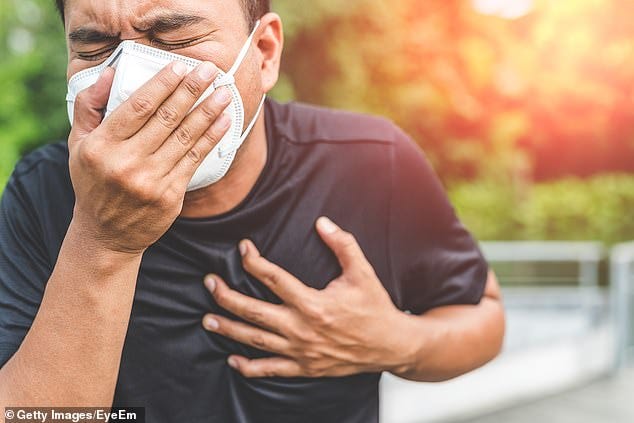Plastic particles found in blood of 80% of people tested while leaders continue demanding your family wear plastics-shedding masks
Having no good evidence of reducing infections, public masking is useful only for ritual submission, gullibility signaling, and evidently getting plastics into human bloodstreams (Updated 12/3/24)
Disclaimer: Some articles in this newsletter aim to figure out who is behind 1) development of the ethnically targeting SARS-CoV-2 spike protein; 2) deadly variant-selecting design of leaky, single-target spike protein vaccines and their mass administration during a pandemic; and 3) mandatory public face masking that is ineffective and harmful. This newsletter rejects racism and antisemitism.
Covid face masks shed small, respirable plastic particles, and a new study suggests 80% of the general population has such plastics in their bloodstream.
These particles can potentially harm the brain, liver, kidney, gut, placenta, and fetus.
Ill intent for mask mandates appears akin to that for water fluoridation, a neurotoxin forced on populations without consent in variable, uncontrolled doses and associated with lower children’s IQ in 74 out of 83 studies investigating the issue.
Plastic particles detected in blood
Yahoo Finance reports:
Tiny particles of plastic have been detected in human blood for the first time, a Dutch study has discovered.
The study, published in the journal Environment International, tested 22 anonymous blood samples and found plastic particles in 80% of people tested—indicating plastic particles may be able to travel around the body and lodge themselves in organs.
Worryingly, mice given large quantities of microplastics were found to have inflammation in their small intestines, lowered sperm count and fewer, smaller pups, compared with control groups.
From the March 2022 Dutch study:
Plastic particles are ubiquitous pollutants in the living environment and food chain but no study to date has reported on the internal exposure of plastic particles in human blood.
This study’s goal was to develop a robust and sensitive sampling and analytical method with double shot pyrolysis - gas chromatography/mass spectrometry and apply it to measure plastic particles ≥700 nm in human whole blood from 22 healthy volunteers.
Four high production volume polymers applied in plastic were identified and quantified for the first time in blood.
Polyethylene terephthalate, polyethylene and polymers of styrene (a sum parameter of polystyrene, expanded polystyrene, acetonitrile butadiene styrene etc.) were the most widely encountered, followed by poly(methyl methacrylate).
Polypropylene was analysed but values were under the limits of quantification.
In this study of a small set of donors, the mean of the sum quantifiable concentration of plastic particles in blood was 1.6 µg/ml, showing a first measurement of the mass concentration of the polymeric component of plastic in human blood.
This pioneering human biomonitoring study demonstrated that plastic particles are bioavailable for uptake into the human bloodstream.
An understanding of the exposure of these substances in humans and the associated hazard of such exposure is needed to determine whether or not plastic particle exposure is a public health risk. …
Masks shed plastic particles that embed in artery walls and associate with 4.5X risk of heart attack, stroke, or death
As reported by Brad Stanfield MD in the video above, a March 2024 study in the New England Journal of Medicine found:
‘Microplastic’ is a term for plastic particles for which no universally established definition exists.
In the literature, microplastic is often defined as plastic particles up to 5 mm in dimensions with no defined lower size limit.
‘Nanoplastic’ is a term for plastic particles in the submicron range, <1 μm. In the nanotechnology field, ‘nanoplastic’ may refer to engineered particles <100 nm, i.e. the nanotechnology application size limit.
To circumvent the ambiguity of the terms microplastic and nanoplastic particles in this article we will refer to ‘plastic particles’ and where appropriate define the size or size range.
Our study was concerned with plastic particles that can be absorbed across membranes in the human body.
…
The uptake routes of plastic particles detected in human bloodstream are likely to be via mucosal contact (either ingestion or inhalation).
Dermal uptake of fine particles is unlikely except if the skin is damaged.
Airborne particles between 1 nm and 20 µm are considered respirable.
Ultrafine (<0.1 µm) inhaled particles may become absorbed and accumulate in the lung, while most larger particles are expected to be coughed up and eventually swallowed, and have a second chance of absorption via the gut epithelium.
Leslie, et al. (2022): Discovery and quantification of plastic particle pollution in human blood
Image source: https://www.nature.com/articles/d41586-021-01143-3
Masks shed plastic particles
Multiple studies such as those listed below show Covid face masks release small plastic particles — as well as toxic metals including lead, cadmium, antimony, and copper — into water and the air we inhale:
Nanoplastics and other harmful pollutants found in disposable face masks (2021)
Covid-19 face masks: A potential source of microplastic fibers in the environment (2020)
How can these plastics harm you?
From the Dutch study:
The fate of plastic particles in the bloodstream needs further study to answer questions regarding the potential accumulation in the general population and occupationally exposed workers, the environmental factors contributing to the internal exposure and toxicological and human health effects that may result from different exposure scenarios.
It is scientifically plausible that plastic particles may be transported to organs via the bloodstream.
The human placenta has been shown to be permeable to 50, 80 and 240 nm polystyrene beads and likely also to microsized polypropylene.
In a study of acute lung exposure to nanopolystyrene spheres (20 nm) in rats, the translocation of plastic particles to placental and fetal tissues was demonstrated.
Bioaccumulation of small polystyrene micro-particles in the liver, kidney and gut was observed after oral administration in mice in vivo.
Further supporting evidence for the translocation of plastic particles comes from drug delivery sciences, where polymeric carriers of pharmaceuticals have been dosed in mammalian test systems.
The polymeric nanosized carriers are able to deliver drugs across the blood brain barrier.
The typical residence time of plastic particle in the bloodstream is at present unknown, as is the fate of these particles in the human body. From polymeric nanocarrier research, we expect the residence time to vary with particle chemistries, surface charges, shapes and sizes.
The plastic particle concentrations reported here are the sum of all potential exposure routes: sources in the living environment entering air, water and food, but also personal care products that might be ingested (e.g. PE in toothpaste, PET in lip gloss), dental polymers, fragments of polymeric implants, polymeric drug delivery nanoparticles (e.g. PMMA, PS), tattoo ink residues (e.g. acrylonitrile butadiene styrene particles).
[A]t least some of the plastic particles humans come in contact with can be bioavailable and that the rate of elimination via e.g. the biliary tract, kidney or transfer to and deposition in organs is slower than the rate of absorption into the blood.
It remains to be determined whether plastic particles are present in the plasma or are carried by specific cell types (and to which extent such cells may be involved in translocating plastic particles across mucosa to the bloodstream).
If plastic particles present in the bloodstream are indeed being carried by immune cells, the question also arises, can such exposures potentially affect immune regulation or the predisposition to diseases with an immunological base?
One study found polystyrene microplastics “caused mitochondrial dysfunction, ER [endoplasmic reticulum] stress, inflammation, and autophagy in kidney cells and accumulated in HK-2 [human kidney] cells and in the kidneys of mice.”
Who is doing this to us?

Who are the leaders pushing masks on Americans? Do any of them identify as a group?
Yes, in fact, they do.
Keep reading with a 7-day free trial
Subscribe to James Hill MD’s Newsletter to keep reading this post and get 7 days of free access to the full post archives.






